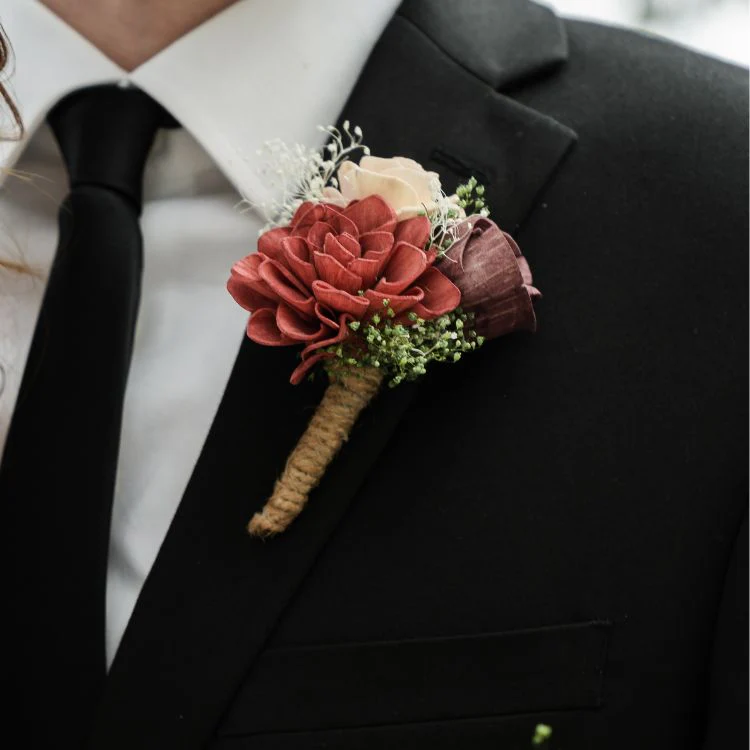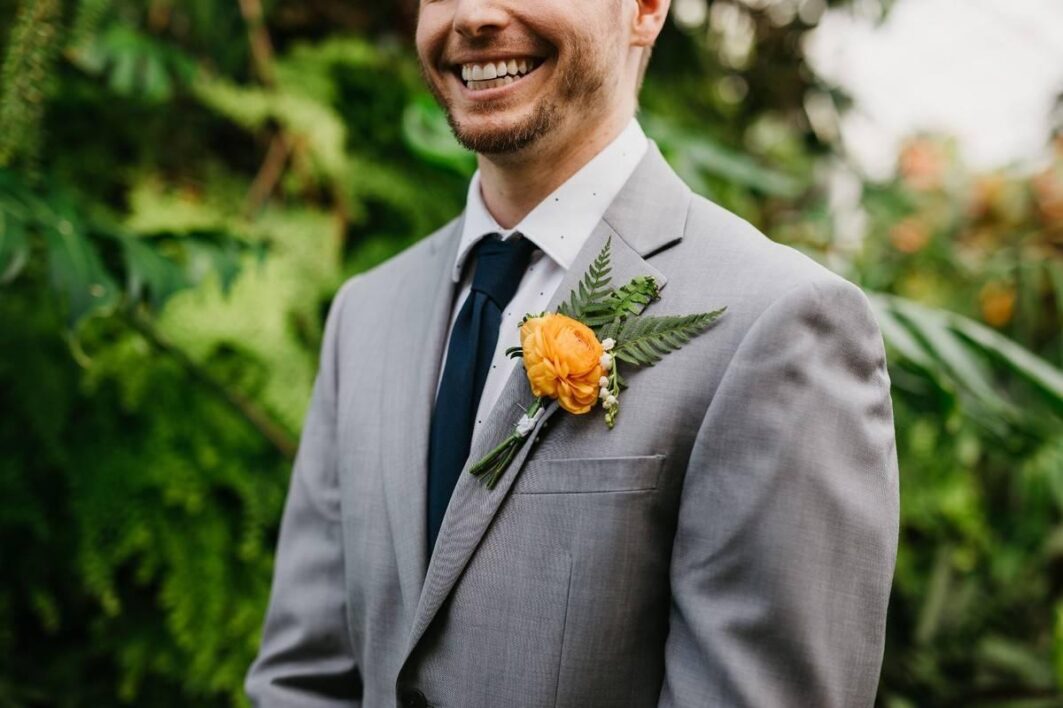
Introduction
The Boutonniere is a small yet significant floral accessory worn by men, typically pinned to the lapel of a suit jacket. Its history is steeped in tradition, and its use spans various cultures and occasions, from weddings to proms and formal events. This article delves into the origins, styles, occasions, and techniques associated with boutonnieres, offering a detailed exploration of this timeless adornment.
Historical Background
The word “boutonniere” originates from the French word for buttonhole, reflecting its initial use as a flower placed in the buttonhole of a lapel. The tradition dates back to the 16th century when men wore flowers in their buttonholes to ward off evil spirits and bad luck. Over time, The Boutonniere evolved into a symbol of elegance and sophistication, often associated with the upper classes and special occasions.
The Evolution of The Boutonniere
In the 19th century, The Boutonniere became a staple in men’s formal attire, particularly in Europe. During the Victorian era, the flower in a man’s lapel symbolized love and admiration, often given by a lady as a token of affection. By the 20th century, The Boutonniere was firmly established in Western fashion, with specific flowers and arrangements signifying different social events and statuses.
Types of Boutonnieres
Boutonnieres can be crafted from a variety of flowers, each carrying its own symbolism and aesthetic appeal. Here are some of the most popular types:
- Rose Boutonniere: The rose is a classic choice for boutonnieres, symbolizing love and passion. It is often chosen for weddings and romantic occasions.
- Carnation Boutonniere: Carnations are versatile and durable flowers that come in a range of colors, each with its own meaning. Red carnations signify admiration, while white carnations represent purity.
- Lily of the Valley Boutonniere: Known for its delicate and fragrant blooms, Lily of the Valley is often used in weddings and symbolizes sweetness and purity.
- Orchid Boutonniere: Orchids convey luxury and sophistication, making them a popular choice for high-end events.
- Calla Lily Boutonniere: Calla lilies are elegant and streamlined flowers, often associated with beauty and refinement.
Choosing the Right Boutonniere
Selecting the appropriate boutonniere involves considering the occasion, the wearer’s attire, and personal preferences. Here are some tips for choosing the right boutonniere:
- Match the Flower to the Occasion: For weddings, choose flowers that complement the bride’s bouquet and the overall color scheme. For proms and formal events, consider matching The Boutonniere to the date’s corsage.
- Consider the Wearer’s Attire: The Boutonniere should complement the color and style of the suit or tuxedo. Classic choices like white or red flowers pair well with black or dark-colored suits, while more vibrant flowers can add a pop of color to lighter attire.
- Personal Preference: Take into account the wearer’s personal style and preferences. Some men may prefer a more traditional flower like a rose or carnation, while others might opt for something unique like a succulent or wildflower.
How to Make a Boutonniere
Creating a boutonniere can be a simple and rewarding DIY project. Here’s a step-by-step guide to making a basic boutonniere:
Materials Needed:
- Fresh flowers of your choice
- Foliage (optional)
- Floral tape
- Floral wire
- Ribbon (optional)
- Scissors or floral shears
- Pins
Steps:
- Select and Prepare the Flowers: Choose a primary flower and any additional blooms or foliage. Trim the stems to about 3-4 inches in length.
- Arrange the Flowers: Start with the primary flower as the focal point and add smaller flowers or foliage around it. Adjust until you achieve a balanced and visually pleasing arrangement.
- Secure with Floral Wire: Wrap floral wire around the stems, just below the blooms, to hold the arrangement together.
- Wrap with Floral Tape: Cover the wire and stems with floral tape, starting from the top and working your way down. Stretch the tape slightly as you wrap to ensure it adheres well.
- Add Ribbon (Optional): If desired, wrap a ribbon around the base of The Boutonniere, securing it with a small dab of hot glue or by tying a bow.
- Trim Excess Stems: Use scissors or floral shears to trim any excess stems, ensuring a clean and neat finish.
- Pin The Boutonniere: Use a pin to attach The Boutonniere to the lapel of the jacket, ensuring it is secure and upright.
Wearing a Boutonniere

The Boutonniere is traditionally worn on the left lapel of a suit jacket, close to the heart. Here are some tips for properly wearing a boutonniere:
- Placement: Insert the pin from behind the lapel, catching a small portion of the flower stem to secure it in place. The flower should sit just below the collarbone.
- Angle: The Boutonniere should be upright or slightly angled outward, showcasing the flower’s bloom.
- Number of Pins: Use one or two pins, depending on the size and weight of The Boutonniere, to ensure it stays securely in place throughout the event.
Occasions for Boutonnieres
Boutonnieres are worn on various formal and semi-formal occasions, each carrying its own significance:
- Weddings: Boutonnieres are a staple in wedding attire, worn by the groom, groomsmen, fathers of the bride and groom, and other male members of the wedding party. They often match the bride’s bouquet and the overall color scheme of the wedding.
- Proms and Dances: High school proms and formal dances are popular occasions for boutonnieres. They are typically coordinated with the date’s corsage and the wearer’s attire.
- Formal Events: Black-tie events, galas, and other formal gatherings often call for boutonnieres as part of the dress code, adding a touch of elegance and refinement to the ensemble.
- Special Celebrations: Anniversaries, milestone birthdays, and other significant celebrations may also warrant the wearing of boutonnieres as a symbol of festivity and honor.
Cultural Significance
The Boutonniere holds cultural significance in various traditions and practices around the world:
- Western Weddings: In Western cultures, boutonnieres are a traditional part of wedding attire, symbolizing love, honor, and celebration.
- Asian Weddings: In some Asian cultures, flowers are used in wedding ceremonies to represent prosperity, happiness, and good fortune. The Boutonniere is a way to incorporate these symbolic flowers into the groom’s attire.
- Proms and Formal Dances: In the United States, the tradition of wearing boutonnieres to proms and formal dances is a rite of passage for high school students, symbolizing youth, beauty, and celebration.
- Royal and State Events: Boutonnieres are often worn by dignitaries and royals during official ceremonies and state events, symbolizing honor and respect.
Care and Preservation
To ensure that boutonnieres remain fresh and vibrant throughout the event, follow these care and preservation tips:
- Refrigeration: Keep The Boutonniere refrigerated until it is time to wear it. This helps maintain the freshness of the flowers.
- Hydration: Mist the flowers lightly with water to keep them hydrated. Be careful not to over-saturate them.
- Avoid Direct Sunlight: Store The Boutonniere in a cool, dark place to prevent wilting and discoloration.
Modern Trends
While traditional boutonnieres remain popular, modern trends have introduced new and creative variations:
- Non-Floral Boutonnieres: Some boutonnieres are made from non-floral materials, such as feathers, herbs, or succulents, offering a unique and contemporary twist.
- Customized Designs: Personalized boutonnieres, incorporating elements like charms, beads, or miniature objects, allow for greater individuality and expression.
- Seasonal Themes: Seasonal flowers and foliage are used to create boutonnieres that reflect the time of year, adding a festive and thematic touch.
Conclusion
The Boutonniere is a timeless and versatile accessory that continues to play a significant role in formal attire and special occasions. Its rich history, cultural significance, and evolving styles make it a cherished element of men’s fashion. Whether crafted from traditional flowers or modern materials, The Boutonniere remains a symbol of elegance, love, and celebration.


